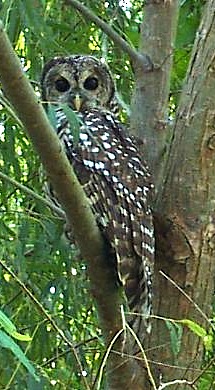We have all heard the phrase – “He can’t see the forest for the trees.” It describes someone who does not visualize the big picture. He can only see the trees immediately in front of him, not the way through the woods. Ironically, this is often true of tree farmers with respect to their long term planning.
Woodland owners are often so focused on the day to day tasks of managing their forest – timber stand improvement, pruning, tree planting, timber sales (the fun stuff); they often do not have a clear vision of where they want to take the tree farm, in the long run. As important as activities such as TSI are to the future of our woodlands, it may be more important to have a crystal clear picture of what we are building during our lifetimes, and after. We wouldn’t begin a long trip without a clear idea of where we want to go, and we shouldn’t manage a tree farm that way, either…. a vision statement is the answer.
A vision statement should be a statement about our dreams. It should capture the essence of our desire for the woodlands that are so important to us. It should be clear and concise. A vision statement does NOT contain specific goals, or strategies. It does not tell how we are going to get there. It simply states where we want to go. It defines why we are in this business, or why we own this woodland. A vision statement becomes a compass. Examples of a properly designed vision statement could be:
-
To provide hunting and recreational opportunities to our children and their families
-
To maximize the long term revenue potential of the timber resources for current and future generations of our family
-
To grow and harvest high quality black walnut timber in sustainable manner
 A properly constructed vision statement should frame the owner’s ultimate goal for the benefit of anyone making decisions regarding the tree farm now, or in the future. It is the beginning of the blueprint for the operating decisions, as well as the estate planning decisions, later on.
A properly constructed vision statement should frame the owner’s ultimate goal for the benefit of anyone making decisions regarding the tree farm now, or in the future. It is the beginning of the blueprint for the operating decisions, as well as the estate planning decisions, later on.
Once a vision statement is in place, a mission statement, and specific goals can be identified. For example, if we take the second vision statement (above), a mission statement for that particular tree farm could be:
Then, specific operating objectives (goals) flow easily from that mission statement:
-
Conduct a timber inventory, this winter
-
Conduct TSI on stands 1, 2 & 3, next year
-
Conduct a professionally managed timber sale on stands 4 & 5 in the next five years
-
Establish a properly designed trust to manage the farm when we are unable to do so.
The real value of a vision statement is that it provides a roadmap for the woodland owner when he/she is faced with complex and difficult decisions. For instance, suppose a husband and wife own 400 acres of prime timberland, which they have managed with care for decades. They want to pass their land, in tact, to their three children and grandchildren. When they sit down with their advisory team (CPA, attorney, and financial advisor) to make estate plans regarding their tree farm, they may be presented with a confusing array of choices regarding estate taxes, gifting, trust provisions, insurance, easements and the like. These choices can be complicated, and seemingly contradictory. It would be easy for this couple to lose their way, unless they are able to keep their eye on the big picture – on what is most important to them. In other words, it would be easy to get lost in the forest, by focusing only on the trees! However, a properly designed vision statement could provide the high altitude perspective they need to stay on track. It should keep them focused on the ultimate goal, and allow them to sort through the various choices in front of them, selecting the ones that best accomplish their vision.
Hundreds of thousands of acres in this state alone are destined to change hands in the next two decades as the current generation of owners’ ages and needs to hand the reigns over to the next generation of their family. These children and grandchildren, many times, have different perspectives and different skill sets than the current owners. This makes the task of transferring the tree farm or woodland, in the manner the owner wishes to transfer it, more difficult. The ultimate success of this ownership transfer is crucial to the future of our great woodlands, and it hinges on successfully communicating and transferring the owner’s vision, first.
So, how clear is your vision?
( Go to the next article, "Meet the Team" )
Photo: Barred Owl, David Arbour, USDA FS